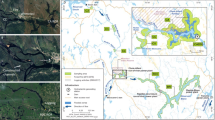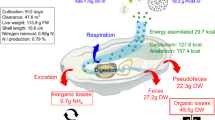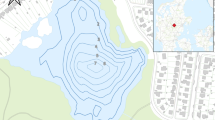Abstract
Estuaries worldwide are increasingly degraded by anthropogenic nitrogen (N) inputs, primarily from their watersheds. In southeastern Massachusetts, several municipalities are implementing floating oyster aquaculture in their estuaries as a means of increasing N removal through assimilation into oyster biomass, sediment burial, and enhanced sediment denitrification. Denitrification associated with floating oyster aquaculture was quantified in a Cape Cod tidal salt pond to determine the effectiveness of this non-traditional approach. Exchange of dinitrogen gas, oxygen, and nutrients between water column and sediments was measured inside and outside of sediment areas affected by oyster biodeposits. Enhanced sediment denitrification was observed during each of the 3 years of the study, with the degree of enhancement varying between seasons and years; enhanced denitrification totaled 2.8, 2.4, and 3.3 g N2-N m−2 (265%, 309%, and 388% of background) for summer and fall months of 2016, 2017, and 2018, respectively. Continued enhanced denitrification each following spring contributed additional N removal, averaging 1.4 g N2-N m−2 (449% of background) beyond previous summer and fall enhancements. Differences in enhanced denitrification were attributable to interannual and seasonal differences in N deposition, bottom water dissolved oxygen, and nitrate + nitrite concentrations. Oyster biomass within each bag and the pond varied by year resulting in differences in the spatial extent and intensity of N biodeposition to surficial sediments, and level of enhanced denitrification. This shows that such information is necessary to assess the efficacy of using floating oyster aquaculture to reach N reduction goals within eutrophic coastal embayments typical of southeastern Massachusetts.





Similar content being viewed by others
References
An, S., and W. Gardner. 2002. Dissimilatory nitrate reduction to ammonium (DNRA) as a nitrogen link, versus denitrification as a sink in a shallow estuary (Laguna Madre/Baffin Bay, Texas). Marine Ecology Progress Series 237: 41–50. https://doi.org/10.3354/meps237041.
Ayvazian, S., K. Mulvaney, C. Zarnoch, M. Palta, J. Reichert-Nguyen, S. McNally, M. Pilaro, A. Jones, C. Terry, and R.W. Fulweiler. 2021. Beyond bioextraction: The role of oyster-mediated denitrification in nutrient management. Environmental Science and Technology 55: 14457–14465.
Bayne, B.L., and A.J.S. Hawkins. 1992. Ecological and physiological aspects of herbivory in benthic suspension-feeding molluscs. In Plant-animal interactions in the marine benthos, ed. D. M. John, S. J. Hawkins, and J. H. Prince, 46th ed., 265–388. Oxford: Clarendon.
Caffrey, J.M., S. Bonaglia, and D.J. Conley. 2019. Short exposure to oxygen and sulfide alter nitrification, denitrification, and DNRA activity in seasonally hypoxic estuarine sediments. FEMS Microbiology Letters. https://doi.org/10.1093/femsle/fny288.
Charoenpong, C.N., L.A. Bristow, and M.A. Altabet. 2014. A continuous flow isotope ratio mass spectrometry method for high precision determination of dissolved gas ratios and isotopic composition. Limnology and Oceanography: Methods 12: 323–337. https://doi.org/10.4319/lom.2014.12.323.
Comeau, L.A. 2013. Suspended versus bottom oyster culture in eastern Canada: Comparing stocking densities and clearance rates. Aquaculture 410–411: 57–65. https://doi.org/10.1016/j.aquaculture.2013.06.017.
D’Elia, C.F., P.A. Steudler, and N. Corwin. 1977. Determination of total nitrogen in aqueous samples using persulfate digestion. Limnology and Oceanography 22: 760–764. https://doi.org/10.4319/lo.1977.22.4.0760.
Engström, P., T. Dalsgaard, S. Hulth, and R.C. Aller. 2005. Anaerobic ammonium oxidation by nitrite (anammox): Implications for N2 production in coastal marine sediments. Geochimica Et Cosmochimica Acta 69: 2057–2065. https://doi.org/10.1016/j.gca.2004.09.032.
Fenchel, T., G.M. King, and T.H. Blackburn. 1998. Bacterial biogeochemistry: The ecophysiology of mineral cycling. London: Academic Press.
Ferreira, J.G., A.J.S. Hawkins, and S.B. Bricker. 2007. Farm-scale assessment of shellfish aquaculture in coastal systems—the Farm Aquaculture Resource Management (FARM) model. Aquaculture 264: 160–174. https://doi.org/10.1016/j.aquaculture.2006.12.017.
Fulweiler, R.W., S.M. Brown, S.W. Nixon, and B.D. Jenkins. 2013. Evidence and a conceptual model for the co-occurrence of nitrogen fixation and denitrification in heterotrophic marine sediments. Marine Ecology Progress Series 482: 57–68. https://doi.org/10.3354/meps10240.
Hamersley, M., and B. Howes. 2005. Coupled nitrification-denitrification measured in situ in a Spartina alterniflora marsh with a 15NH4+ tracer. Marine Ecology Progress Series 299: 123–135. https://doi.org/10.3354/meps299123.
Higgins, C., C. Tobias, M. Piehler, A. Smyth, R. Dame, K. Stephenson, and B. Brown. 2013. Effect of aquacultured oyster biodeposition on sediment N2 production in Chesapeake Bay. Marine Ecology Progress Series 473: 7–27. https://doi.org/10.3354/meps10062.
Howarth, R.W., A. Sharpley, and D. Walker. 2002. Sources of nutrient pollution to coastal waters in the United States: Implications for achieving coastal water quality goals. Estuaries 25: 656–676. https://doi.org/10.1007/BF02804898.
Howes B., S.W. Kelley, J.S. Ramsey, R. Samimy, D. Schlezinger, E. Eichner (2006). Linked watershed-embayment model to determine critical nitrogen loading thresholds for Pleasant Bay, Chatham, Massachusetts. Massachusetts Estuaries Project, Massachusetts Department of Environmental Protection. Boston, MA.
Humphries, A.T., S.G. Ayvazian, J.C. Carey, B.T. Hancock, S. Grabbert, D. Cobb, C.J. Strobel, and R.W. Fulweiler. 2016. Directly measured denitrification reveals oyster aquaculture and restored oyster reefs remove nitrogen at comparable high rates. Frontiers in Marine Science 3: 41–50. https://doi.org/10.3389/fmars.2016.00074.
Jorgensen, C.B. 1975. Comparative physiology of suspension feeding. Annual Review of Physiology 37: 57–79. https://doi.org/10.1146/annurev.ph.37.030175.000421.
Joye, S.B., and J.T. Hollibaugh. 1995. Influence of sulfide inhibition of nitrification on nitrogen regeneration in sediments. Science 270: 623–625. https://doi.org/10.1126/science.270.5236.62.
Kellogg, M.L., J.C. Cornwell, M.S. Owens, and K.T. Paynter. 2013. Denitrification and nutrient assimilation on a restored oyster reef. Marine Ecology Progress Series 480: 1–19. https://doi.org/10.3354/meps10331.
Kellogg, M.L., A.R. Smyth, M.W. Luckenbach, R.H. Carmichael, B.L. Brown, J.C. Cornwell, M.F. Piehler, M.S. Owens, D.J. Dalrymple, and C.B. Higgins. 2014. Use of oysters to mitigate eutrophication in coastal waters. Estuarine, Coastal and Shelf Science 151: 156–168. https://doi.org/10.1016/j.ecss.2014.09.025.
Koop-Jakobsen, K., and A.E. Giblin. 2009. Anammox in tidal marsh sediments: The role of salinity, nitrogen loading, and marsh vegetation. Estuaries and Coasts 32: 238–245.
Kristen, W. 1983. Organic Elemental Analysis: Ultramicro, Micro, and Trace Methods. New York: Academic Press/Harcourt Brace Jovanovich.
Labrie, M.S., M.A. Sundermeyer, and B.L. Howes. 2022. Modelling the spatial distribution of oyster (Crassostrea virginica) biodeposits settling from suspended aquaculture. Estuaries and Coasts. https://doi.org/10.1007/s12237-022-01096-4.
Lohrenz, S.E., C.D. Taylor, and B.L. Howes. 1987. Primary production of protein: 2. Algal protein metabolism and its relation to particulate organic matter composition in the surface mixed layer. Marine Ecology Progress Series 40: 175–183.
Lunstrum, A., K. McGlathery, and A. Smyth. 2018. Oyster (Crassostrea virginica) Aquaculture shifts sediment nitrogen processes toward mineralization over denitrification. Estuaries and Coasts 41 (4): 1130–1146. https://doi.org/10.1007/s12237-017-0327-x.
Magni, P., S. Montani, C. Takada, and H. Tsutsumi. 2000. Temporal scaling and relevance of bivalve nutrient excretion on a tidal flat of the Seto Inland Sea, Japan. Marine Ecology Progress Series 198: 139–155. https://doi.org/10.3354/meps198139.
Murphy, J., and J.P. Riley. 1958. A single-solution method for the determination of soluble phosphate in sea water. Journal of the Marine Biological Association of the United Kingdom 37: 9–14. https://doi.org/10.1017/S0025315400014776.
Newell, R.I.E., and S.J. Jordan. 1983. Preferential ingestion of organic material by the American oyster Crassostrea virginica. Marine Ecology Progress Series 13: 47–53. https://doi.org/10.3354/meps013047.
Oudot, C., R. Gerard, P. Morin, and I. Gningue. 1988. Precise shipboard determination of dissolved oxygen (Winkler procedure) for productivity studies with a commercial system. Limnology and Oceanography 33: 146–150.
Owens, M.S. 2009. Nitrogen Cycling and Controls on Denitrification in Mesohaline Sediments of Chesapeake Bay. Master’s Thesis: University of Maryland, College Park, MD, USA.
Piehler, M.F., and A.R. Smyth. 2011. Habitat-specific distinctions in estuarine denitrification affect both ecosystem function and services. Ecosphere 2: 1–17. https://doi.org/10.1890/ES10-00082.1.
Ray, N.E., B. Hancock, M.J. Brush, A. Colden, J. Cornwell, M.S. Labrie, T.J. Maguire, T. Maxwell, D. Rogers, R.J. Stevick, and A. Unruh. 2021. A review of how we assess denitrification in oyster habitats and proposed guidelines for future studies. Limnology and Oceanography: Methods 19 (10): 714–731.
Reitsma, J., D. Murphy, and A. Franklin. 2014. Shellfish nitrogen content from coastal waters of southeastern Massachusetts. Ext: Woods Hole Sea Grant Cape Cod Coop.
Rich, J.J., O.R. Dale, B. Song, and B.B. Ward. 2008. Anaerobic ammonium oxidation (anammox) in Chesapeake Bay sediments. Microbial Ecology 55: 311–320. https://doi.org/10.1007/s00248-007-9277-3.
Rose, J.M., S.B. Bricker, and J.G. Ferreira. 2015. Comparative analysis of modeled nitrogen removal by shellfish farms. Marine Pollution Bulletin 91: 185–190. https://doi.org/10.1016/j.marpolbul.2014.12.006.
Rose, J.M., J.S. Gosnell, S. Bricker, M.J. Brush, A. Colden, L. Harris, E. Karplus, A. Laferriere, N.H. Merrill, T.B. Murphy, and J. Reitsma. 2021. Opportunities and challenges for including oyster-mediated denitrification in nitrogen management plans. Estuaries and Coasts 44: 2041–2055.
Rudnick, D.T., and C.A. Oviatt. 1986. Seasonal lags between organic carbon deposition and mineralization in marine sediments. Journal of Marine Research 44: 815–837. https://doi.org/10.1357/002224086788401594.
Scheiner, D. 1976. Determination of ammonia and Kjeldahl nitrogen by indophenol method. Water Research 10: 31–36. https://doi.org/10.1016/0043-1354(76)90154-8.
Smyth, A.R., S.P. Thompson, K.N. Siporin, W.S. Gardner, M.J. McCarthy, and M.F. Piehler. 2013. Assessing nitrogen dynamics throughout the estuarine landscape. Estuaries and Coasts 36 (1): 44–55. https://doi.org/10.1007/s12237-012-9554-3.
Songsangjinda, P., O. Matsuda, T. Yamamoto, N. Rajendran, and H. Maeda. 2000. The role of suspended oyster culture on nitrogen cycle in Hiroshima Bay. Journal of Oceanography 56: 223–231. https://doi.org/10.1023/A:1011143414897.
Srna, R.F., and A. Baggaley. 1976. Rate of excretion of ammonia by the hard clam Mercenaria and the American oyster Crassostrea virginica. Marine Biology 36: 251–258. https://doi.org/10.1007/BF00389286.
Town of Orleans Water Quality and Wastewater Planning. 2018. Amended Comprehensive Wastewater Management Plan – Final. Pocasset: AECOM Technical Services Inc.
Wood, E.D., F. Armstrong, and F.A. Richards. 1967. Determination of nitrate in sea water by cadmium-copper reduction to nitrite. Journal of the Marine Biological Association of the United Kingdom 47: 23–31. https://doi.org/10.1017/S002531540003352X.
Acknowledgements
The authors would like to thank the United States Environmental Protection Agency Southeast New England Program and the Town of Orleans for supporting this work. We gratefully acknowledge Science Wares Inc. for maintaining the oyster arrays and their assistance determining oyster survival, growth, and nitrogen assimilation and D.R. Schlezinger, J. Benson, S. Horvet, A. Unruh, and N. Uline of the Coastal Systems Program at SMAST-UMD. Special thanks to Dr. Mark Altabet for use of the MC-IRMS, which is part of the Stable Isotope Facility at UMassD/SMAST. We would also like to extend our gratitude to the two anonymous reviewers whose comments significantly improved this manuscript.
Author information
Authors and Affiliations
Corresponding author
Additional information
Communicated by Eric N. Powell
Rights and permissions
Springer Nature or its licensor (e.g. a society or other partner) holds exclusive rights to this article under a publishing agreement with the author(s) or other rightsholder(s); author self-archiving of the accepted manuscript version of this article is solely governed by the terms of such publishing agreement and applicable law.
About this article
Cite this article
Labrie, M.S., Sundermeyer, M.A. & Howes, B.L. Quantifying the Effects of Floating Oyster Aquaculture on Nitrogen Cycling in a Temperate Coastal Embayment. Estuaries and Coasts 46, 494–511 (2023). https://doi.org/10.1007/s12237-022-01133-2
Received:
Revised:
Accepted:
Published:
Issue Date:
DOI: https://doi.org/10.1007/s12237-022-01133-2




